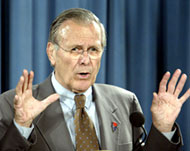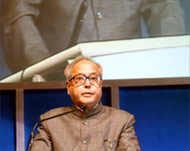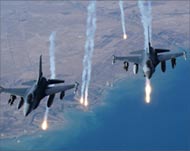India, US sign 10-year defence pact
Defence ministers of the United States and India have signed a 10-year agreement paving the way for joint weapons production.

The agreement also deals with cooperation on missile defence and possible lifting of US export controls on sensitive military technology.
“The United States and India have entered a new era,” a statement said after the signing by US Defence Secretary Donald Rumsfeld and his Indian counterpart, Pranab Mukherjee, who is on a visit to Washington.
“We are transforming our relationship to reflect our common principles and shared national interests,” it said of the so-called “new framework for the US-India defence relationship” signed at the Pentagon.
The ministers agreed to set up a “defence procurement and production group” to oversee defence trade, as well as prospects for co-production and technology collaboration” and sign deals on military “research, development, testing and evaluation” as well as naval pilot training.
“Today, we agree on a new framework that builds on past successes, seizes new opportunities and charts a course for the US-India defence relationship for the next 10 years,” the statement said.
Major world power
The military pact comes three months after the US unveiled plans to help India become a “major world power in the 21st century” and ahead of a visit by Indian Prime Minister Manmohan Singh at the invitation of US President George Bush from 18 to 20 July.
 |
|
Rumsfeld: The United States and |
Singh is scheduled to address a joint meeting of Congress.
House of Representatives Speaker Dennis Hastert said on Tuesday that he looked forward to hearing from the visitor “how our two countries can help grow the global economy and make our world safe from those who seek to do us harm”.
Washington‘s move to boost relations between the two countries which were on the opposite sides in the Cold War is seen by analysts as part of a strategy to counter the growing influence of China, India‘s immediate neighbour.
Permanent member
The US may back India’s bid to become a permanent member in the UN Security Council, aside from its already pledged support for Japan, some analysts say.
 |
|
Mukherjee: Some areas of the |
Mukherjee said the US could also end its policy of restricting supply of dual use nuclear and space technologies to India, sanctions imposed after India became an undeclared nuclear power.
“I feel there is a possibility of a change,” he told reporters.
He said specific areas for cooperation under the new agreement would be subject to negotiations but urged defence companies to study the different defence procurement procedures of the two countries to achieve quick results.
Strengthening ties
Rumsfeld did not speak to reporters but had said recently that US military ties with India would be strengthened and predicted that China‘s influence would decline unless it moved to a freer political system.
“It’s pretty clear where India‘s going, and one would anticipate the relationship with India will continue to strengthen as we go through the period ahead,” Rumsfeld had said.
 |
|
F-16 warplanes may be used by |
Washington has given the green light to Lockheed Martin and Boeing to offer F-16 and F-18 warplanes as candidates for the Indian Air Force’s multi-role fighter programme, while also pledging support for Indian requests for other transformative systems in areas such as command and control, early warning, and missile defence.
India has relied so far on French and Russian frontline fighters.